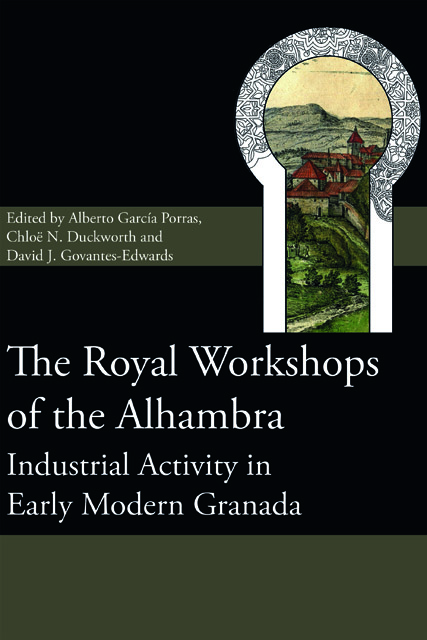Book contents
- Frontmatter
- Contents
- List of Illustrations
- List of Contributors
- Acknowledgements
- Foreword
- Introduction
- 1 The Secano: the city of the Alhambra
- 2 A holistic and reflexive methodology for the archaeological investigation of pyrotechnological activity in the Alhambra
- 3 The modern kilns
- 4 Geophysical and geochemical exploration of the industrial areas in the Alhambra
- 5 The excavation of the area of the Secano in the Alhambra: Trench 1
- 6 The excavation of the area of the Secano in the Alhambra: Trench 2
- 7 The pottery
- 8 Glass in the excavation of the Secano, the Alhambra
- 9 Furnaces at full blast: the demand for architectural ceramics for construction in the Alhambra (16th and 17th centuries)
- Conclusions
- Index
9 - Furnaces at full blast: the demand for architectural ceramics for construction in the Alhambra (16th and 17th centuries)
Published online by Cambridge University Press: 20 December 2023
- Frontmatter
- Contents
- List of Illustrations
- List of Contributors
- Acknowledgements
- Foreword
- Introduction
- 1 The Secano: the city of the Alhambra
- 2 A holistic and reflexive methodology for the archaeological investigation of pyrotechnological activity in the Alhambra
- 3 The modern kilns
- 4 Geophysical and geochemical exploration of the industrial areas in the Alhambra
- 5 The excavation of the area of the Secano in the Alhambra: Trench 1
- 6 The excavation of the area of the Secano in the Alhambra: Trench 2
- 7 The pottery
- 8 Glass in the excavation of the Secano, the Alhambra
- 9 Furnaces at full blast: the demand for architectural ceramics for construction in the Alhambra (16th and 17th centuries)
- Conclusions
- Index
Summary
Although the Nasrid palaces and other buildings in the Alhambra are generally seen as the zenith of Andalusi architecture, the truth is that, to a large extent, what we see today is the result of construction and maintenance work undertaken after, and sometimes long after, the Castilian conquest. Even though the administrators of the fortress during the 16th and 17th centuries often tried to follow Nasrid aesthetic canons, the work carried out in some of the palatial spaces inevitably led to considerable changes in decoration. However, what is most interesting about this is that the written record related to these works reveals that a very significant proportion of the materials used in this maintenance work was produced in the Alhambra itself, and that this is probably the clearest piece of evidence to date as to the scale of industrial production in the early modern Alhambra, which is much greater than the extant archaeological remains on display for the visitors could suggest. This chapter aims to present data about Alhambra-based production of architectural ceramics and to provide some details about the administrative process involved in their purchase and some steps in the chaîne opératoire that brought them from the kiln to the walls and rooftops of the palaces. The so-called Palace of Comares will be used as a case study to thread through the narrative, although other spaces in the Alhambra will also be considered.
Keywords: Alhambra; Nasrid palaces; industrial activity; construction work.
Introduction
This chapter examines the demand for ceramic construction material in Granada after the conquest of the city, the last redoubt of al-Andalus, in 1492. Specifically, I shall focus on the royal construction works undertaken in the Alhambra. My aim is to establish beyond doubt whether the pottery kilns in the Alhambra remained active after the Catholic Monarchs’ conquest and, if this was the case, the scale of their operation.
The time span under examination includes the 16th and the first half of the 17th century, a period during which the administration of the Alhambra, and therefore the maintenance work undertaken there, was in the hands of the Tendilla family, which held the position of alcaides of the Alhambra almost without interruption during this period, and they were always very keen to maintain the fabrics and decorations of the palace to the highest standards. The enquiry stops in 1646, when the VII Count of Tendilla left office.
- Type
- Chapter
- Information
- The Royal Workshops of the AlhambraIndustrial Activity in Early Modern Granada, pp. 149 - 166Publisher: Boydell & BrewerPrint publication year: 2022

